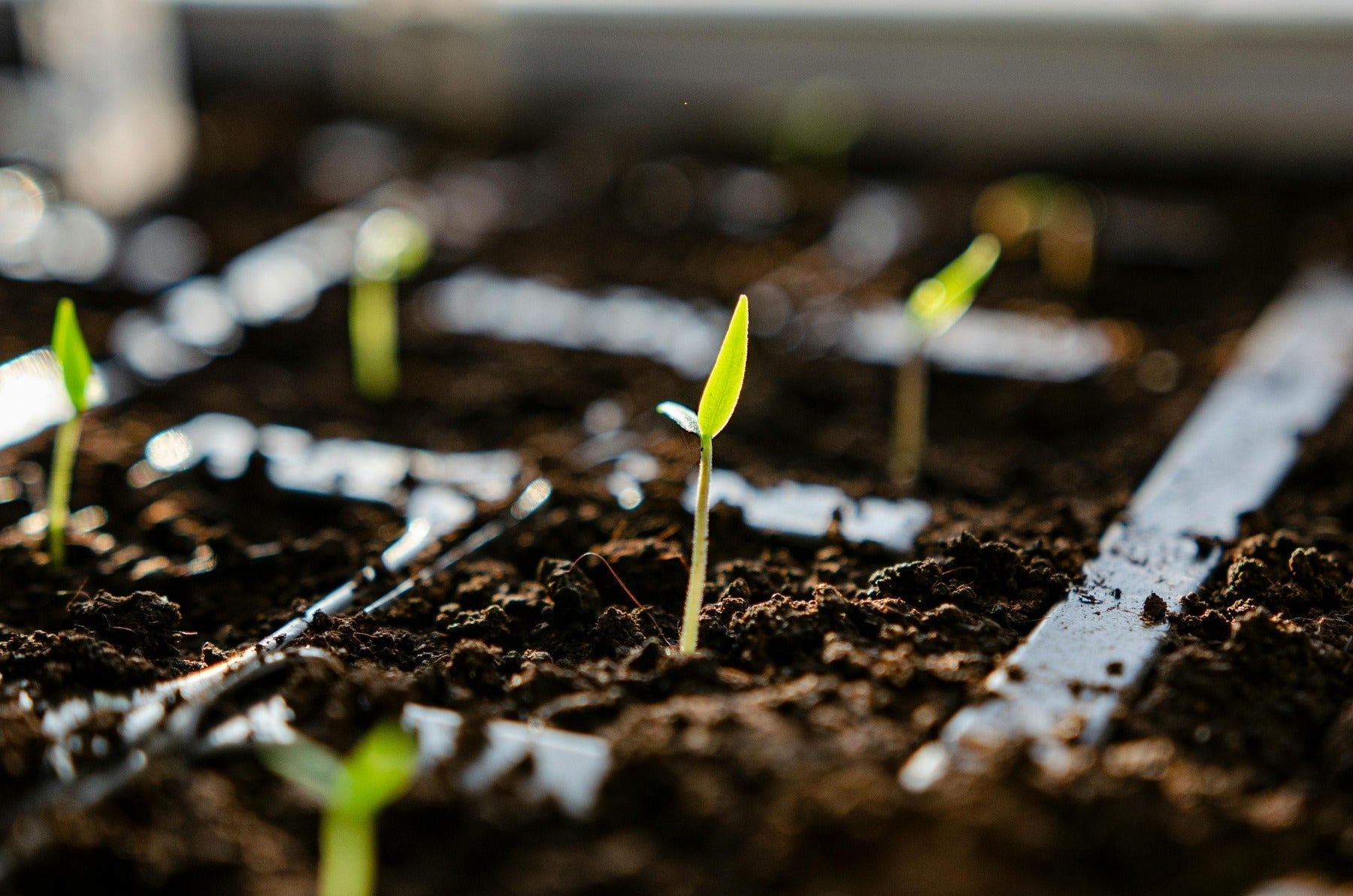What is seed stratification? This is a common question among home gardeners who get frustrated with seeds refusing to sprout. Based on our first-hand experience successfully planting and harvesting native plants through seed stratification, we're going to explain what seed stratification is, including its benefits and various cold and warm stratification techniques.
What Is Seed Stratification?
Seed stratification is a natural process mimicking the winter conditions seeds experience in their native habitats before seeds germinate. Many perennials, trees, and native wildflower seeds have evolved a protective dormancy that prevents them from sprouting until they've experienced a period of cold, moist conditions. Different techniques use a temperature change to trigger and break dormancy.

Seeds naturally stratify when they fall to the ground and remain there through winter months, where freezing temperatures and moisture gradually break down their protective coating. For gardeners wanting to grow plants whose seeds require cold stratification, you can recreate this process to achieve successful germination.
Overview of Seed Stratification
Mother Nature gives protection and germination mechanisms to seeds. Many seeds begin to immediately germinate and grow when given the moisture and light they need. However, seeds germinate only after a period of cold temperatures to break dormancy
Many of these seeds require moisture during this cold period. These seeds typically have very hard seed coats and moisture can only get into the seed once this outer coat is broken down during cold moist.
|
Aspect |
Details |
|
Purpose |
Break dormancy that prevents seeds from germinating at inappropriate times |
|
Types |
Cold stratification and warm stratification |
|
Common methods |
Refrigerator method, outdoor method, paper towel method, sand method |
|
Temperature |
33 to 41 degrees F (cold stratification), 68 to 86 degrees Fahrenheit (warm stratification) |
|
Duration |
Typically one to four months depending on the species |
|
Success indicators |
Seed swelling, emergence of the first root, higher germination percentages |
Type of Seeds That Require Stratification
Seeds that require stratification are mostly wildflowers, particularly native plants. Native plants like milkweeds, penstemons, false indigo, leadplant, and bee balm. Ornamental plant species such as lavender, purple top verbena, catnip, delphinium, poppies, and sweet peas.
This is why some of these flowers are best sown as soon as the ground can be worked in late winter to early spring. In more temperate climates you can sow in early winter to make sure the seed coats are broken down properly.
Reasons Why Gardeners Should Imitate the Seed Stratification Process
In general, you can mimic this natural process for a predictable and reliable germination. Here are some common situations:
-
Commercial farmers stratify seeds to achieve simultaneous germination, making crop production more predictable and profitable.
-
Home gardeners use stratification to coordinate planting with their region's specific frost dates.
-
Controlled stratification can accelerate germination that might otherwise take months or years to occur naturally.
-
Stratification provides greater success when working with rare seed varieties or those with hard seed coats.
Methods to Stratify Seeds
Understanding different seed stratification techniques can help effectively break seed dormancy in various plant species. Whether you choose to stratify seeds indoors or outdoors, you can achieve successful germination and propagation.
1. Sowing in Media
For sowing in media, you can either sow directly in your planting containers you will use for plant starts or in smaller containers with the idea of transplanting once they sprout. For really small seeds, I prefer to use propagation trays where the seeds like lilies can grow for several weeks or months without having to transplant.
-
Mix seeds with moist, sterile growing medium (peat moss, vermiculite, or sand).
-
Place in a sealed container labeled with seed type and date.
-
Store at the recommended temperature for your specific seeds.
-
Cover your planting container or place it in a plastic bag to prevent the media and the seed from drying out.
-
Remove once seeds show signs of germination.

2. Winter Sowing
Winter sowing is taking advantage of natural conditions in a more controlled way. The most popular way is to sow seeds in milk jugs (with holes for drainage) and place them outside in early winter. You can also plant in traditional flats and leave them exposed to cold temperatures. The seeds will typically germinate once the proper cold temperatures are reached.
-
Fill containers with drainage holes with three to four inches of potting soil.
-
Sow seeds, water thoroughly, and allow to drain.
-
Secure lids on containers with small ventilation holes.
-
Place outdoors in a protected location exposed to natural elements.
-
Monitor in spring and transplant seedlings once the weather warms.
3. Cold Moist Stratification
The cold moist stratification technique exposes the seeds to cold, moist conditions, mimicking conditions in the water. This method for cold moist stratification is particularly helpful when you want to direct seed outside during late spring and summer or if you want to start in a larger container.
-
Mix seeds with moist substrate (sand, vermiculite, or peat moss).
-
Place the mixture in a ziplock bag or sealed container.
-
Refrigerate at 33 to 41 degrees Fahrenheit for four to 12 weeks.
-
Check periodically to keep the substrate moist.
-
Remove and sow when the stratification period is complete.
4. Cold Stratification
For cold stratification to be effective, most seeds need to be exposed to cold and adequate moisture. To do this you can use natural conditions for cold stratification like sowing in late fall to early spring. You can simulate natural conditions to make sure that the cold moist period is successful and stratify seeds inside.
-
Combine the seeds with peat moss or damp sand to prevent them from drying out.
-
Place dry seeds in a paper towel or breathable container.
-
Store in refrigerator at 33 to 41 degrees Fahrenheit for four to 12 weeks.
-
Remove after the specified time period (varies by species).
-
Sow immediately after cold treatment.
5. Warm Moist Stratification
To induce natural conditions for warm moist stratification you can mimic the paper towel method described above. Dahlia enthusiasts often use this method to plant the seeds once they sprout.
-
Mix seeds with moist substrate (peat moss, vermiculite, or sand).
-
Place in a sealed plastic bag or container.
-
Maintain temperature between 68 to 86 degrees Fahrenheit.
-
Continue for one to three months, depending on the seed type.
-
Sow once sprouting occurs.

6. Outdoor Stratification
You can try outdoor stratification to sow seeds in the fall. This technique is ideal for large-scale restoration projects that need winter-like temperatures for stratification.
-
Select a sheltered outdoor location with good drainage and protection from predators.
-
Fill a container with drainage holes and a mix of sand and compost.
-
Sow seeds at appropriate depth (generally twice the seed diameter).
-
Cover with wire mesh to protect from birds and rodents.
-
Allow the containers to remain outdoors through winter to experience natural temperature fluctuations then transplant seedlings in spring after germination.
Importance of Seed Stratification
Seed stratification mimics natural winter conditions required to break dormancy, providing a number of benefits when gardening.
-
Breaking seed dormancy: Seeds need cold stratification to overcome endogenous or exogenous dormancy. This process weakens the seed coat and triggers germination in dormant seeds.
-
Improving seedling health: Stratified seeds produce more vigorous seedlings that better resist pests and adapt to environmental conditions.
-
Increasing germination success: Native plants often have significantly higher and more uniform germination rates. For instance, seed packets undergo proper stratification using methods involving peat moss.

Related Questions
How Do You Stratify Seeds?
To stratify seeds, place them in a moist medium like sand, vermiculite, or paper towels, then store them in a refrigerator (around 35 to 41 degrees Fahrenheit) for the period specified for your particular plant variety. Different plants require different stratification periods, typically ranging from four to 12 weeks depending on the species.
What Happens if You Don't Stratify Seeds?
If you don't stratify seeds, they may fail to germinate entirely or germinate very sporadically with low success rates. Seeds that have evolved to require a cold period will remain dormant without stratification. This is because natural germination inhibitors haven't been broken down by the cold and moisture exposure.
Should I Soak Seeds Before Stratification?
You may soak seeds for 12 to 24 hours before stratification to soften the seed coat and jump-start the dormancy-breaking process. This pre-soaking step is particularly beneficial for seeds with hard outer coatings, letting moisture penetrate more effectively during the cold stratification period.
Conclusion
Whether you use warm or cold moist stratification, learning seed stratification can transform your gardening techniques, enabling you to successfully grow hundreds of lily plants and beautiful native plants. Start your seed stratification journey today and grow nature's hidden treasures waiting dormant in those seemingly stubborn seeds.


